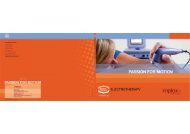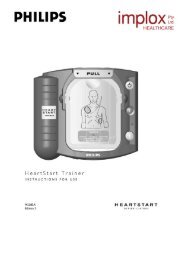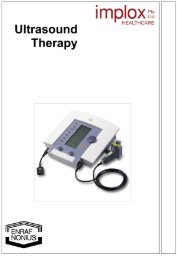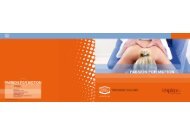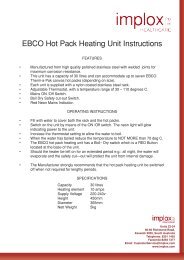intraosseous infusion - Implox
intraosseous infusion - Implox
intraosseous infusion - Implox
Create successful ePaper yourself
Turn your PDF publications into a flip-book with our unique Google optimized e-Paper software.
LaRocco and Wang IO INFUSION 283<br />
Critical Care, Figure 4) contain threaded needles that<br />
facilitate needle insertion into bone.<br />
Spring-loaded auto-injector IO devices have been<br />
recently developed that facilitate easier and quicker IO<br />
needle placement. For example, the bone injection gun<br />
(BIG, WaisMed, Tri-anim, Sylmar, CA) is a springloaded<br />
auto-injection device (Figure 5). Depth of insertion<br />
can be controlled by the device. Spriggs et al.<br />
showed that emergency medical technician trainees<br />
found the BIG to be faster (12 sec vs. 17 sec) but similar<br />
in ease of use to the traditional Jamshidi IOI needle. 29<br />
However, Gilman et al. found no difference between<br />
traditional IO needles and the BIG with respect to<br />
placement time and success rate. 30 When compared<br />
with saphenous vein cutdown, paramedic students<br />
found the BIG to have a shorter time to insertion, a<br />
higher success rate, and fewer complications. 31<br />
The F.A.S.T.1 (Pyng Medical Corporation,<br />
Vancouver, BC, Canada) uses the sternum for IO<br />
access (Figure 6). It employs a target patch to ensure<br />
proper location (15 mm below the sternal notch) and<br />
an introducer with a predetermined depth setting to<br />
prevent overpenetration of the sternum. It can provide<br />
flow rates ranging from 30 mL/min (gravity) to 125<br />
mL/min (pressure cuff or syringe bolus). 32 F.A.S.T.1 is<br />
similar to other IOI techniques with regard to mean<br />
insertion time (77 seconds) and overall adult vascular<br />
access success rate (84%). 33 Astudy comparing the<br />
BIG, Sur-Fast, Jamshidi, and F.A.S.T.1 found all<br />
devices to have similar success rates and access times;<br />
however, F.A.S.T.1 was slower to insert. All devices<br />
were rated as easy to learn, but the BIG was rated as<br />
the first or second choice in 65%. 34<br />
COMPLICATIONS<br />
The risks and complications of IOI are rare and outweighed<br />
by the benefits of immediate vascular access<br />
for administration of fluids or medications.<br />
Extravasation of fluid is the most common complication;<br />
this may occur from a misplaced needle, from<br />
FIGURE 4. The Sussmane-Razynski needle (Cook Critical Care, Inc.,<br />
Bloomington, Indiana).<br />
FIGURE 5. The bone injection gun (BIG—WaisMed, Tri-anim,<br />
Sylmar, California).<br />
multiple attempts in the same bone, or from movement<br />
of the needle enlarging the penetration site. If<br />
caustic medications are being infused (for example,<br />
dopamine), this may lead to necrosis of muscle and<br />
other subcutaneous tissues. Extravasation may also<br />
precipitate compartment syndrome leading to a<br />
potential loss of limb. Osteomyelitis is a rare complication,<br />
occurring in 0.6% of cases 3 ; this occurs most<br />
frequently with prolonged needle placement, preexisting<br />
bacteremia, and the use of hypertonic fluids.<br />
Promptly replacing the IO needle with conventional<br />
peripheral or central venous access may minimize<br />
these complications.<br />
Rarely, fractures at the insertion site, compartment<br />
syndrome, fat emboli, cellulitis, and local abscess have<br />
occurred. 35,36 The theoretical complication of injury to<br />
the epiphyseal growth plate has not been supported<br />
by long-term prospective radiographic analyses of tibial<br />
length. Fiser et al. followed ten subjects radiographically<br />
to evaluate tibial length discrepancy one<br />
or more years after IOI; they found no difference<br />
between the lengths of the tibias with and without the<br />
IOI. 37 IOI has not been demonstrated to cause histologic<br />
damage to metaphyseal cell lines or morphologic<br />
damage to the growth plate of rabbits. 38<br />
USE OF IOI IN ADULTS<br />
The use of IOI in adults is an area of much debate.<br />
Vascular red marrow is typically replaced by fat-laden<br />
yellow marrow by age 5, suggesting that children<br />
under age 6 are the best candidates for IOI. 20 Many<br />
authors feel that adults are not suitable candidates for<br />
IOI because of the increased difficulty of needle insertion<br />
through the thicker cortex of bone and smaller<br />
marrow cavity; this may lead to an increase in complications,<br />
especially fractures. 39 Although there is conjecture<br />
that the relative lack of red bone marrow in the<br />
adult may limit <strong>infusion</strong> rates, modest <strong>infusion</strong> rates<br />
of 20–25 mL/min using fluid bolus injection techniques<br />
have been achieved. 40<br />
Because the sternum retains a relatively large proportion<br />
of its red marrow, IOI can be accomplished



